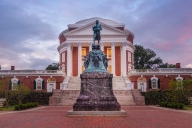You have /5 articles left.
Sign up for a free account or log in.
While the protests that swept campuses in the fall semester varied, most focused on issues of race.
This semester, students have resumed protests, especially in the past few weeks, with a series of sit-ins and lengthy protests in public spaces.
These appear to share less in the way of a theme, though students involved will tell you they are still connected. Students at Clemson University have been staging a days-long protest -- during which several were arrested for trying to occupy a campus building -- focusing on the university’s racial climate. A recent protest at the University of Washington also focused on race.
But other campus protests have widened their scope. Duke University protesters -- who occupied the president’s office for a week -- are fighting for employees’ rights and a $15 minimum wage for all campus employees. Students at Appalachian State University, who also staged a sit-in, want to hear officials there denounce North Carolina’s bathroom bill, which bars transgender students from using restrooms and locker rooms that don’t match their assigned gender at birth. Ohio State University protesters are demanding transparency on finances and divestment from several companies with operations in Israel. Some of these protests -- while not primarily focused on race -- have touched on the issue. Duke students, for example, regularly pointed out that many of the employees paid the least on campus are not white.
These protests also vary widely in length. Duke’s has continued for weeks now, whereas Ohio State’s sit-in ended the same night it began. At Clemson occupiers were shut down swiftly, via arrests for trespassing, but the protest continued outside in tents.
As these protests and sit-ins have unfolded, many on social media have expressed solidarity with the activism on other campuses, suggesting common ground among those taking action.
Activists at Duke posted a statement that read, in part, “We stand in solidarity with students at Ohio State, Appalachian State, UC Davis and beyond who are currently occupying their administrative spaces. We see their campaigns and ours as part of a larger resurgence of student activism addressing deep systematic issues that require transparency and action from university officials.”
Mina Ezikpe, who participated in Duke sit-in, also added in an interview that insufficient or hypocritical administrative leadership connect the various protests.
“The way that universities espouse a certain rhetoric of progressiveness and then those same universities repress social change and repress students on campus is very much connected,” she said. “It’s also about holding our institutions accountable for the ideals they espouse all the time to us …. Why is it the university that tells us we have the power to make the world a better place, but those same people running the university are so shocked the students would actually try to hold them accountable to those ideals they tell us about all the time?”
Shell Sindle, a student at Ohio State who helped organize the protests there, said many campus protests are also fighting disenfranchisement. “Most campaigns are generally interested in democratization of our universities,” she wrote in an email. “Most every protest and campaign can get behind that without compromising their primary goal. We want a seat at the table; we want to be an integrative part of the decision-making process.”
The demands Sindle and her compatriots have put to their university’s administration are notable in light of the many pronouncements of solidarity between campuses. They feature the priorities of three student organizations but ask that the university only commit to progress on at least one.
“The issue is not the issue,” said Angus Johnston, a historian who tracks student activism, echoing a common saying from protests in the 1960s, with which, he added, current student activism shares more than a passing similarity.
“Frequently when you’re organizing on a campus, the immediate proximate cause … it’s only a small part of why you are organizing,” he said. “Something may light the fire and spur you to action, but it’s not the only thing you are dissatisfied with about the way the campus is run or in larger society.”
Another important factor unique to this wave of protests, Johnston said, is how skilled students are at building coalitions, be they between groups on campus (like at OSU), local communities (a feature of the Duke sit-in) or race, gender and ideology.
“This generation of students are much, much better at building those bridges across communities than previous waves of activism in the United States,” he said. The issues themselves aren’t new, though -- recent protests center on racial justice, economic access, sexual harassment and workers’ rights. But, he added, “There is definitely something new in the level and intensity and breadth of the organizing that’s happening.”




